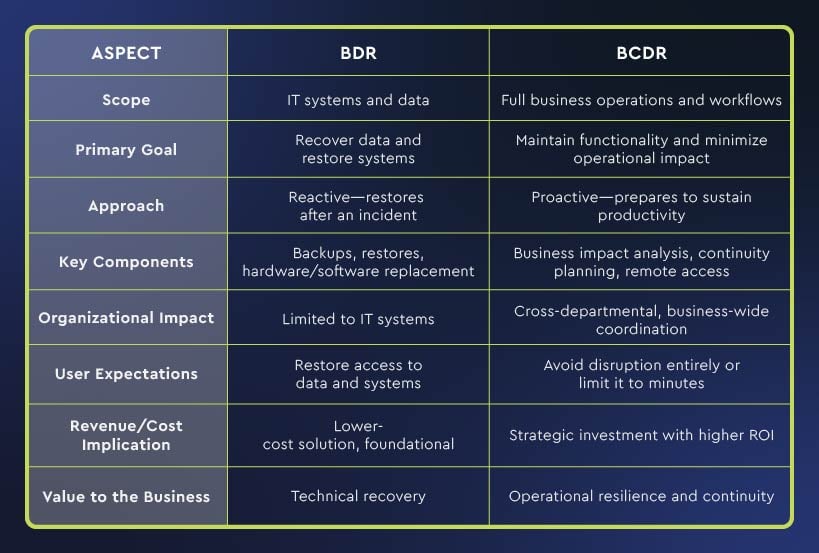Key takeaways
- BDR is focused on restoring data and systems, while BCDR expands to keep the entire business running during a crisis
- MSPs offering only BDR risk falling short of customer expectations in a ransomware-driven world
- Upgrading to BCDR can boost operational agility, reduce client risk, and create new revenue streams
- Ten actionable steps can help MSPs modernize offerings and deliver full-spectrum continuity protection
Many managed service providers (MSPs) and IT teams still rely on traditional backup and disaster recovery (BDR) to protect data, but recovery alone is no longer enough. In a world of ransomware, outages, and rising customer expectations, keeping systems online and operations moving is just as critical as restoring files.
That’s where business continuity and disaster recovery (BCDR) come in. While BDR focuses on getting data back, BCDR ensures the business keeps running, no matter what.
In this blog, we’ll break down the difference between BDR and BCDR and share ten practical ways MSPs and IT professionals can evolve their strategy to deliver stronger protection, faster recovery, and more value.
What is BDR?
Backup and disaster recovery (BDR) refers to a set of technologies and processes that ensure critical data and systems can be restored after a disruption. At its core, BDR is about protecting data and enabling recovery, whether from accidental deletion, hardware failure, or a limited outage.
Two key performance indicators drive every BDR solution:
Occasionally, these two concepts can cause confusion and appear to overlap. For more information, check out this blog explaining the difference between RTO and RPO.
BDR solutions typically include routine backups (local, cloud, or hybrid), versioning, and the ability to restore files, applications, or entire systems. The focus is on post-event recovery, ensuring systems can be brought back online as quickly and cleanly as possible.
Common BDR use cases include:
- A user accidentally deletes important files or folders
- A server fails due to hardware malfunction
- A power outage causes localized system downtime
While effective for protecting data, BDR alone may not address broader business disruptions such as supply chain issues, facility closures, or prolonged system outages.
What is BCDR?
Business continuity and disaster recovery (BCDR) builds on BDR by ensuring that entire business operations can continue during and after a crisis. BCDR is not just about restoring data. It’s about keeping the business running when systems, people, or locations are impacted.
A robust BCDR strategy includes:
- Maintaining critical operations: Ensuring departments such as sales, support, finance, and operations stay functional
- Client communication plans: Keeping customers informed during outages or service interruptions
- Remote work accessibility: Enabling staff to work from alternate locations without loss of productivity
- Disaster recovery response: Ensuring rapid data restoration and business continuity with a hybrid-cloud backup strategy
Where BDR is often reactive, BCDR is inherently proactive. It involves risk assessments, scenario planning, employee training, and technology integrations designed to prevent outages from stopping business activity altogether.
This approach is especially critical for industries with high compliance standards or operational sensitivity, such as:
- Healthcare (e.g., HIPAA requirements)
- Financial services (e.g., SEC/FINRA rules)
- Legal, manufacturing, and government sectors
Download the Backup Compliance Handbook to explore the most common compliance standards shaping the industry and how to adhere to established frameworks.
BCDR gives businesses a framework for survival and stability in the face of unplanned disruptions, whether that’s a ransomware attack, natural disaster, or pandemic-scale event.
BDR vs BCDR: Key differences for MSPs and IT teams
For MSPs and internal IT teams, the distinction between BDR and BCDR has a direct impact on how services are delivered, how systems are protected, and how the organization recovers from disruption. Both approaches deal with disaster recovery, but the scope, objectives, and strategic value differ in critical ways.

BDR may be suitable for handling isolated incidents such as server crashes or accidental file deletion, but it falls short when the entire business faces a larger threat, such as a ransomware attack, natural disaster, or extended outage. In those moments, the ability to maintain customer service, internal communication, and employee access to systems becomes far more important than just recovering data.
MSPs offering only BDR risk being seen as reactive or limited in scope, while those who deliver full BCDR strategies can command higher-value contracts and build longer-term relationships. Similarly, internal IT teams that champion continuity planning often gain strategic influence within the business by directly supporting uptime, compliance, and revenue continuity.
Why MSPs and IT teams must evolve: Modern threats require more than backup
Traditional backup solutions were designed for simpler failures: hardware issues, accidental file deletion, or isolated server outages. But ransomware has changed the game. Attackers not only encrypt data; they often target backups, interrupt operations, and demand payment to restore access. In many cases, the cost of downtime far exceeds the ransom itself.
MSPs and IT professionals who rely solely on backup and restore capabilities may find themselves unprepared when clients or internal stakeholders need to stay operational during a prolonged incident.
Today’s business leaders, whether clients of an MSP or executives supported by an in-house IT department, are no longer satisfied with data recovery alone. They expect:
- Minimal disruption to employee productivity
- Real-time failover of systems and applications
- Clear communication during incidents
- Proactive recovery plans that go beyond file restoration
That level of assurance only comes with a true BCDR approach, which combines data protection with operational strategy.
10 ways MSPs and IT teams can level up from backup to business continuity
1. Protect everything
Clients are now distributed across remote offices, home networks, cloud apps, and mobile devices. That creates more endpoints and more risk. Traditional file-level backups or server-only recovery plans no longer cover the full picture.
True continuity means protecting all client infrastructure: workstations, cloud servers, SaaS software such as Microsoft 365® and Google Workspace, and legacy on-premises systems. Ransomware, data theft, and misconfigurations can strike anywhere, so coverage needs to be universal.
To stay competitive and resilient, MSPs and IT teams must deliver end-to-end protection, ensuring every system and data source can be quickly restored, no matter where it lives.
2. Consider deployment options
Every client has different infrastructure, budgets, and risk profiles. That is why a one-size-fits-all deployment strategy doesn’t work.
Flexible BCDR deployment options include:
- Direct-to-cloud for protecting remote endpoints and cloud workloads without appliances
- Appliance-based BDR for clients needing local failover or faster on-site recovery
- Hybrid models that support both on-prem and cloud-based replication
With BCDR solutions such as x360Recover from Axcient™, a ConnectWise company, you can choose between endpoint backup, cloud-native protection, or full-service BDR, meeting each client’s needs without sacrificing profitability or recovery performance.
3. Get agile
Agility in BCDR means adapting to client preferences and evolving infrastructure. MSPs and IT teams need freedom to deploy using their preferred hardware (BYOD), integrate with OEM vendors, and choose between public or private clouds.
With solutions that support custom licensing and multiple environments, providers can standardize deployments, reduce operational friction, and ensure consistent recovery outcomes across diverse clients.
4. No more chains
Traditional image-based backups rely on chained snapshots, where each recovery point depends on the integrity of the previous ones. If one link breaks, recovery can fail entirely.
Chain-free backup architecture eliminates that risk. Every recovery point is independent, so corruption or deletion won’t jeopardize data availability. This also reduces storage bloat and lowers maintenance overhead.
Solutions such as x360Recover use pointer-based arrays to create flexible, resilient recovery points, ensuring fast, reliable, and recovery-ready backups at all times.
5. Protect endpoints
Endpoints are often the weakest link in business continuity. Laptops and workstations contain critical data and system configurations, but many remain under-protected, especially in remote environments.
Endpoint protection is essential. Built-in features such as anti-ransomware, auto-validation of backups, and fast local recovery options allow MSPs and IT teams to safeguard dispersed workforces without relying on complex, high-touch processes.
With the right solution, you can consolidate endpoint security, speed up restores, and reduce total cost of ownership.
6. Upgrade legacy deployments
Many providers are burdened by outdated BDR appliances and fragmented vendor ecosystems. Swapping out legacy tech used to mean rip-and-replace disruptions, but not anymore.
With hardware-free solutions such as x360Recover direct-to-cloud, you can silently deploy modern agents via RMM, run backups in parallel, and decommission legacy infrastructure with zero downtime.
Upgrading doesn’t have to be painful. A streamlined, silent migration path helps MSPs and IT teams modernize environments quickly and profitably.
7. Standardize and save
Standardization simplifies everything, from procurement and deployment to billing and support. A single BCDR solution reduces the complexity of managing multiple tools, vendors, and licensing models.
Using one solution across your client base means faster technician training, more efficient troubleshooting, and better scalability. It also cuts overhead, boosts profit margins, and empowers sales teams to sell confidently with a unified message.
8. Harness automation
Manual backup checks, test restores, and reporting drain time and resources. Automation changes the game.
With features such as AutoVerify and centralized health monitoring, BCDR solutions can automatically validate backups, detect issues, and generate status reports, freeing technicians to focus on strategic work.
Less manual effort means better consistency, faster issue resolution, and stronger margins for your service desk.
9. Never pay ransoms
Ransomware continues to evolve, often targeting both live systems and backup files. If recovery points are compromised, paying the ransom may feel like the only option.
That’s where AirGap technology comes in. It isolates backup data from tampering, ensuring copies can’t be deleted, even by authenticated threats. Combined with chain-free architecture and immutable storage, it forms a last line of defense against extortion.
For MSPs and IT teams, this means greater client trust, fewer emergency escalations, and stronger cyber resilience.
10. Add up the profits
By consolidating tools, streamlining deployment, reducing labor, and cutting vendor overhead, MSPs and IT teams can turn continuity into a high-margin, recurring revenue service.
x360Recover, for example, helps partners reduce recurring costs, simplify operations, and deliver fast, reliable recovery, all with a single solution. The result is better protection for clients and higher profits for providers.
By adopting these ten strategies, MSPs and IT teams can deliver more complete protection, streamline operations, and offer high-value services that keep businesses running, no matter what.
Conclusion
As cyberthreats grow more sophisticated and downtime becomes more costly, the difference between basic backup and true business continuity has never been more important. BDR may recover your data, but only a well-structured BCDR strategy ensures your clients or business operations stay online, productive, and protected.
For MSPs and IT teams, this evolution presents a clear opportunity: deliver more value, reduce risk, and grow recurring revenue by moving beyond legacy backup tools. With the right solution, continuity becomes simpler to manage, easier to scale, and far more profitable.
Ready to level up your BCDR strategy?
Download the BCDR Buyer’s Guide to evaluate your options and learn more about how Axcient x360Recover can help you protect everything, recover faster, and build a more resilient service stack.














